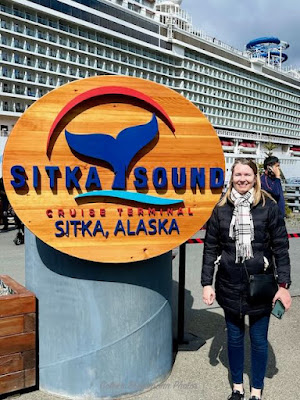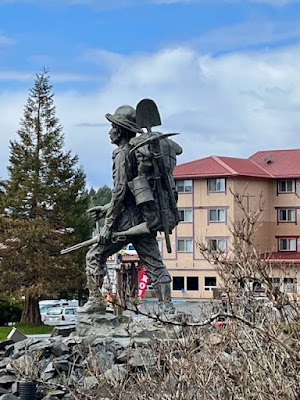Hubby and I joined our daughter on an Alaskan cruise last week. She booked the cruise to celebrate her 50th Birthday and since no one should celebrate their 50th alone...we came along. Hubby and I had been on an Alaska land and sea cruise in 2001 with my parents and one of my brothers and his wife. That 15 day adventure was very memorable and allowed us to see a lot. So this trip of 5 ports, 6 days was just right. The weather for May can be quite iffy, but other than clouds and overcast, we lucked out; temps in the 40ºs - 50ºs and no rain or snow like they had the week before.
Our first port of call was Sitka. I was very excited about this port as we had not been there in 2001.
The green domes or cupolas, historic icons, tower bells, and golden Orthodox crosses of Holy Russia are still visible and functioning in Sitka at Saint Michael's Cathedral.
The original Saint Michael's Cathedral was completed in 1848 in Sitka; Bishop Veniaminov designed the Cathedral and oversaw its construction. Financial support came from the Russian-America Company's headquarters in Siberia. Many of the construction materials and most of the icons and liturgical items came by a land and sea route from Russia. In the frigid early morning hours of January 2, 1966, Saint Michael's Cathedral burned to the ground during a devastating night fire that destroyed 17 downtown buildings, including the historic Lutheran Church across the street.
Courageous parishioners and townspeople managed to save almost everything from inside the burning Cathedral by forming a human chain and passing along ancient liturgical treasures from one person to another. The massive metal bells and the tower clock melted, but the pieces of melted bells were later recast into the present bells, and the clock was replaced. A few days after the fire, services were held outside on top of the Cathedral's ashes, and reconstruction efforts were initiated.
By 1976, Saint Michael's Cathedral was reconstructed by using architectural drawings fortuitously made in 1961 by the Historic American Buildings Survey. All of the rescued icons and other historic liturgical items were set back in place, where they remain today.

Today, this active parish is composed principally of Native Alaskans, most of whom are descendants of the same Tlingit families who were living in the area at the time of Russian colonization.















No comments:
Post a Comment
Thanks for your comments!